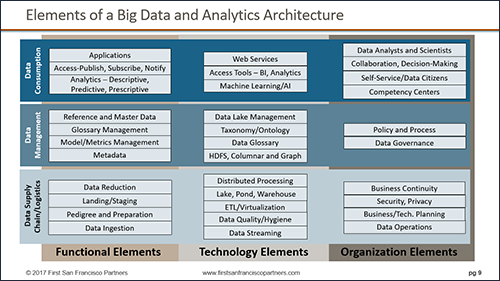We kicked off our April 6 Data Insights & Analytics webinar with this polling question: “Where is your organization in its readiness to develop a formal Big Data and analytics architecture?”
Our Building a Flexible and Scalable Analytics Architecture audience, which included data management professionals from around the world, could choose one of these answers:
- We have no plans or architecture for analytics, but want to have one.
- We have a strategy and are planning an architecture.
- We have started to implement a planned architecture for analytics.
- None of the above.
The results of the poll were that 21% chose answer #3. With that information in-hand, our DATAVERSITY webinar co-hosts Kelle O’Neal and John Ladley spent the next hour covering four main topics:
- What is a Big Data and analytics architecture?
- When should Big Data and analytics architectures be employed?
- Key components for Big Data architecture systems
- Best practices for analytics architectures

“Elements of a Big Data and Analytics Architecture” — one of First San Francisco Partners’ Data Insights & Analytics webinar slides (view full slide deck here)
What follows are some of the analytics architecture best practices John and Kelle shared on the call. To experience the full webinar, visit DATAVERSITY’S archive where you can listen to the audio recording and view the presentation material. (Be sure to look for the analogy comparing the Winchester Mystery House to a discombobulated architecture!)
– Apply different lenses to the desired architecture, considering:
- Form – i.e., an architecture needs to be one that stakeholders can understand and provide input on
- Progression – i.e., an architecture that is business-appropriate and effective, whether a simple or complex structure is required
– A Big Data and analytics architecture needs to consider all three forms:
- Abstract: Enables and conveys insight so it can be considered and adopted
- Apparent: Obvious structure so it can be used to manage data, as well as interface with people and processes
- Explicitly Planned: Must be comprehensive, not just a technology stack and an arrow-filled diagram, so it effectively manages and sustains the environment
– Reconcile old/existing architectures to desired/future state. Look at:
- Business needs
- Current-state technology
- Available elements
- Future-state technology
- Requirements based on your combination of the V’s (veracity, variety, volume and velocity) and “net new” (not counting what was already there or done before)
– Like an I-beam, the data architecture needs to take the load of meeting business objectives, distributing that load to supportive structures.
(Find more best practices and tips from the Data Insights & Analytics webinar here.)
Next Up in May: A Data Scientist Interview
Please join us for next month’s DIA webinar on Thursday, May 4: The Role of a Data Scientist — an interview with Narasimha Edala, a Chief Data Scientist at Data Bloom. Learn more and RSVP.

